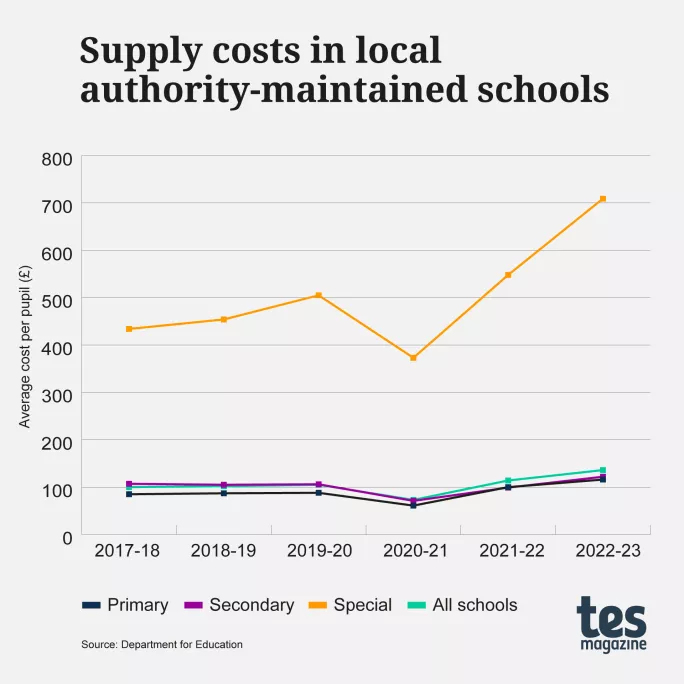Revealed: The ‘sickening’ rise in supply costs hitting schools

A Tes investigation has revealed the “sickening” extent of rises in supply costs facing trusts and schools across the country.
Leaders say the rise is driven by the growing support needs of pupils, as well as ongoing teacher shortages and higher supply prices.
While many multi-academy trusts (MATs) saw supply costs fall over the pandemic, the latest annual accounts reveal they have since risen significantly compared with before Covid-19.
Maintained schools have seen a similar pattern, with supply spend per pupil rising by a third between 2018-19 and 2022-23 according to government data. Local authority-run special schools have been hit particularly hard, with per pupil costs shooting up by 56 per cent over that time, Tes analysis reveals.
It is “sickening to think of such sums of money going out of education and away from the young people who need it most at what is such a challenging time for school leaders”, warned Pepe Di’Iasio, incoming general secretary of the Association of School and College Leaders (ASCL).
- Feature: How England lost its teachers - and how it can get them back
- Revealed: The schools worst hit by the costs crisis
- Funding: Schools ‘face new financial crisis’ as costs remain high
While many MATs have acquired more schools and pupils since before the pandemic, their supply costs often far outstrip this.
The REAch2 primary MAT took on two extra schools between 2018-19 and 2022-23, rising to 60 schools in total, but supply costs grew by 53 per cent to £4.65 million. Its supply costs per pupil increased from £172.45 to £232.77.
A spokesperson for REAch2 said schools are being forced to rely on long-term agency cover due to recruitment challenges and staff sickness issues affecting the whole sector.
The trust added it was more concerned about the “considerable variability” in supply staff available, and called for the government to double down on efforts to tackle the recruitment and retention crisis.
The Harris Federation gained six schools between 2018-19 and 2022-23, bringing its total to 52. During this time, supply costs increased by 70 per cent, to £9.78 million.
SEND pressures adding to supply cost
For some schools, the rise is being driven largely by the need to support the growing number of pupils with education, health and care plans (EHCPs).
Lighthouse Schools Partnership, based in Somerset, grew from 22 to 30 schools over the four years to 2022-23, with recurring income growing by 50 per cent to £69.50 million. But the trust’s total expenditure on supply rose by 117 per cent to £813,000.
Gary Lewis, chief executive of Lighthouse Schools Partnership, said the MAT had seen supply costs rise most sharply for learning support assistants carrying out one-to-one support, partly driven by the rising number of pupils with EHCPs.
Last year, the number of EHCPs rose to above half a million for the first time, amid warnings that schools were being overwhelmed by the increase.
Mr Lewis said that one of the drivers for the increased need for learning support assistants is the “absolute legal obligation to provide one-to-one support very frequently stipulated in EHCPs”.
“In a context of declining funding, higher identified special educational needs, higher staff absence and recruitment problems, we have had to use agencies more than we would wish,” he added.

Ark Schools has seen supply costs grow by 60 per cent since 2018-19 to over £10 million in 2022-23. A spokesperson told Tes that reducing supply spend “is a priority for us as it is for all schools”.
Its supply expenditure per pupil in 2018-2019 was £260, compared with £362 in 2022-2023, according to our analysis.
The spokesperson said the numbers include some teaching assistants who support pupils with special educational needs or disabilities (SEND) but who do not have EHCP funding.
“In these cases, the school can only hire interim staff,” they said. The trust has also slightly altered how it reports supply numbers, which accounts for some of the increase.
Recruitment challenges
The recruitment challenges in the sector as a whole are cited by leaders as one of the main factors driving increased spending on supply.
The government missed its targets for the recruitment of trainee secondary teachers by 50 per cent this year. At the same time, there has also been an increase in the number of new teachers leaving the sector after their first year.
James Bowen, assistant general secretary of the NAHT school leaders’ union, said there is “little alternative but to turn to supply” when schools are facing recruitment difficulties.
And, as the cost of supply teachers rises, school budgets are often hit with “double the pain”, he added.
Meridian Trust grew from 13 to 29 schools from 2019 to 2023, leading to a 153 per cent rise in revenue income - but its agency costs have risen during that period by 423 per cent. Supply costs per pupil have grown from £78.15 to £121.61.
The trust put the gap down to inflation and a “challenging” recruitment picture.
The Cabot Learning Federation gained six schools between 2018-2019 and 2022-23, growing to 25 schools. Its supply costs rose from £1.88 million to £3 million, which works out as 16.3 per cent more per pupil.
Supply staff ‘significantly more expensive’
Dixons Academies Trust, which has seen a 165 per cent rise in supply costs against a 110 per cent rise in income, said the unit cost of supply staff had gone up.
The impacts of cost inflation on trusts were set out in the latest Kreston UK Academies Benchmark Report, which found nearly half of academy trusts reported an in-year revenue deficit for 2022-23.
Many are also having to eat into their reserves to cope with cost rises.
Accountants found that small MATs were worse affected by supply staff increases, with supply costs per pupil in the sample it covered rising by 20 per cent on the year before, compared with an average of 9.7 per cent for large MATs.
Single-academy trusts saw a decrease in supply costs year-on-year, though accountants said this may be because they could not afford them.
A sector-wide issue
Meanwhile, it is not just academy trusts seeing an increase - a similar pattern is found among maintained schools, particularly special schools, a Tes analysis of government data reveals.
Special schools saw spending on supply per pupil jump by 56 per cent from 2018-19 to 2022-23, while primary schools saw per-pupil spending increase by 33 per cent. There was a 16 per cent increase in per-pupil spending at secondary schools.
In 2022-2023, special schools spent £62.27 million on supply teaching staff, almost doubling the £37.88 million recorded in 2018-2019.

ASCL’s SEND specialist Margaret Mulholland said it was “particularly worrying” that supply staff use in special schools is increasing as the complexity of pupils’ needs increases.
She said: “There were recruitment and retention issues in special schools long before the pandemic and the current escalation of demand for high-needs places.
“When the TA is replaced with temporary solutions, the loss of consistency, knowledge and skill is detrimental to the children.”
Ms Mulholland added that it is also “increasingly difficult” to find and retain long-term supply. She said many special schools are looking at deficit budgets, but need to make sure they maintain staff-to-pupil ratios to keep children safe.
Schools left with ‘no choice’ but to pay finders’ fees
Many schools can also face extra costs from some supply agencies if they want to appoint teachers to full-time posts - these are called finders’ fees or supply release costs.
“You often see finders’ fees up to around 20 per cent of the salary the supply teacher is being appointed to,” said Niall Bradley, chair of the National Supply Teachers Network.
“In rare cases, I’ve heard of them being up to £17,000. There is a worry schools may not want to take someone on from an agency because they can’t afford the finders’ fee,” he added.
Caroline Spalding, deputy head at maintained secondary Littleover Community School in Derby, said her school has been asked to pay release costs of around 20 per cent of the salary for supply teachers on the highest band of the teacher pay scale who they have wanted to appoint to full-time roles. This can cost around £9,000.
While the fees are not new, Ms Spalding said the recruitment crisis has left the school with “no choice” but to pay them.
She said: “Despite the expense, we may have to do this again - but what’s the option when you need a teacher standing in front of your class and you need the best teacher you possibly can?”
She added: “Staffing is the biggest challenge against the budget for us right now.”
Agencies ‘have to pay more to supply teachers’
Some supply agencies say they are also struggling to recruit, which pushes costs up. Regional supply teacher agency Pro Education said that finding supply teachers “is a lot harder than it was” and that “we are having to pay more to the teacher”.
Pro Education supplies all its schools through the Crown Commercial framework, so its profits have not increased with inflation, and will not until the contract renews, a spokesperson said.
They added: “All schools have the option to use this framework - not only does it reduce the cost of supply, it offers a free transfer after 12 weeks should they want to hire them permanently.”
The spokesperson added that the actual cost of paying supply teachers is the biggest increase to schools and “if they are paying teachers to teach, they should expect the teacher to be appropriately remunerated”.
Labour shadow schools minister Catherine McKinnell said: “Supply teachers make a valuable contribution to our classrooms, but this rise in spending by schools speaks to the deepening crisis in teacher recruitment and retention.
“The Conservatives have created the perfect storm in our teaching workforce, with teachers old and new leaving and with too few replacing them.”
She added that Labour plans to recruit an additional 6,500 teachers.
A DfE spokesperson said there are now record numbers of teachers in schools and £196 million is being spent this year to recruit more teachers.
The spokesperson added that school funding is rising to the highest ever level in real terms per pupil next year. The DfE is also investing in the high-needs budget to bring it to £10.5 billion, and improving provision through the SEND improvement plan.
All trusts have been contacted for comment.
For the latest education news and analysis delivered directly to your inbox every weekday morning, sign up to the Tes Daily newsletter
You need a Tes subscription to read this article
Subscribe now to read this article and get other subscriber-only content:
- Unlimited access to all Tes magazine content
- Exclusive subscriber-only stories
- Award-winning email newsletters
Already a subscriber? Log in
You need a subscription to read this article
Subscribe now to read this article and get other subscriber-only content, including:
- Unlimited access to all Tes magazine content
- Exclusive subscriber-only stories
- Award-winning email newsletters



